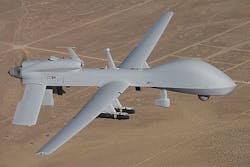Army extends support for UAV man-hunting radar from Northrop Grumman through 2013
ABERDEEN PROVING GROUND, Md., 7 Feb. 2013. U.S. Army officials have announced their intention to extend support for a radar system for unmanned aerial vehicles (UAVs) and manned aircraft that is specially designed to detect and track moving land vehicles and even detect and follow people traveling on foot.
Officials of the Army Contracting Command at Aberdeen Proving Ground, Md., plan to award a sole-source contract from April to December 2013 to the Northrop Grumman Corp. Electronic Systems segment in Linthicum, Md., to operate the Vehicle and Dismount Exploitation Radar (VADER) on UAVs and manned aircraft.
VADER is designed to track vehicles and foot traffic over a wide area from UAVs and manned aircraft, and provide Army ground commanders with real-time ground moving target indicator (GMTI) data and synthetic aperture radar (SAR) imagery. The system is designed especially for the General Atomics MQ-1C Grey Eagle UAV.
The upcoming contract will call for Northrop Grumman to operate and maintain two VADER systems for Operation Enduring Freedom in Afghanistan, and one system in the U.S., through the rest of this year.
The contract will have options to add a third VADER man-hunting radar system in Afghanistan to ensure 24-hour operations, and extend operating and maintenance of the UAV radar through the end of 2014. These particular VADER systems will be operated from a manned fixed-wing aircraft that Northrop Grumman will supply.
A Tactical Common Data Link (TCDL) transmits VADER data to an exploitation ground station with the remote radar control, mission planning, and exploitation equipment.
Northrop Grumman initially completed VADER flight testing three years ago. "The flight tests not only proved that the system can detect individuals walking over a wide area, but it can track over varying ranges, altitudes and platform speeds as well," Steve McCoy, vice president of the Northrop Grumman Electronic Systems Advanced Concepts business unit said at the time.
Northrop Grumman won the VADER development contract in 2006. The project has sponsorship from Joint Improvised Explosive Device Defeat Office (JIEDDO), the Defense Advanced Research Projects Agency (DARPA), and the Defense Microelectronics Activity (DMEA), as well as from the Army Intelligence and Information Warfare Directorate.
VADER's exploitation suite includes the DARPA NetTrack tool for persistent reconnaissance, surveillance, tracking, and targeting of evasive vehicles and people moving on foot in cluttered environments.
The system operates in two modes: as a synthetic aperture radar for high-resolution still images, and as a real-time ground moving target indicator for detecting and tracking moving targets -- particularly moving vehicles and humans on foot.
The overall idea of the VADER system is to detect teams planting improvised explosive devices (IEDs) to destroy or damage U.S. military vehicles and personnel. VADER also has been demonstrated to track animals and boats.
The VADER's ground moving target indicators detect the Doppler shift that moving objects produce in radar return signals, Northrop Grumman officials say. Doppler shift is a change in the frequency of the radar return caused by the motion of the target. Because there is no shift caused by stationary objects, the shift reveals moving objects.
VADER transmits processed signals from the aircraft to ground stations, where operators can view still high-contrast black-and-white synthetic aperture radar images, or moving targets displayed as dots on a map.
For more information contact Northrop Grumman Electronic Systems online at www.es.northropgrumman.com, or the Army Contracting Command at www.army.mil/ACC.
